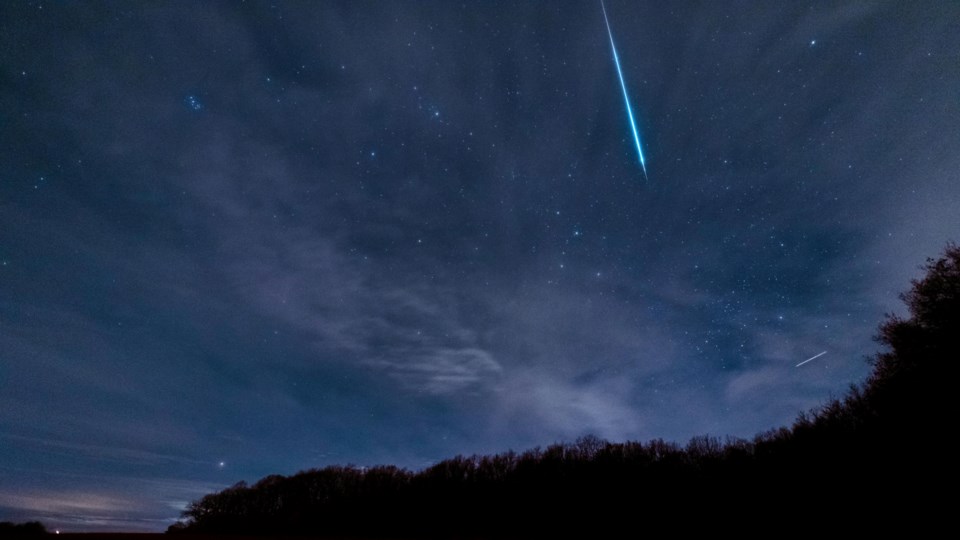Environment Canada's weather forecast for Friday the 13th says the night sky will be clear, which provides the perfect opportunity to enjoy the Geminid meteor shower at its peak.
Geminid is the biggest meteor shower of the year. The meteors became visible on Dec. 4 and will be until Dec. 17.
Remember when you were a kid and you saw a shooting star and made a wish?
Now imagine seeing up to 120 meteors per hour as that's what expected during it's middle-of-the-night peak.
“But that’s under ideal conditions with a perfect night sky – there’s no moon – that’s how many you’d be able to see and what you’re seeing with these meteor events whereby a meteor is just a streak of light in the night sky, when a rock, or ice or metal enters our atmosphere it begins breaking up,” said Patrick Hill, Canadian Space Agency mission scientist (planetary science).
“We have these showers when the Earth’s orbit crosses a debris cloud left behind by comets, or in this special case the Geminid is actually from an asteroid called 3200 Paethon, named for Paethon, the helper of the Greek God, Helios, who drove the sun chariot and that’s because the asteroid goes so close to the sun.”
With as many as 120 meteors per hour is there any danger to the Earth and its humans?
“With the Geminid showers and most of the meteor shower events most of the debris is burning up in the atmosphere very high up and that’s what you’re seeing with that streak of light," Hill said.
"Scientists do believe that some can make it to the ground as a meteorite if it is big enough. Those fall to the ground and they freefall but don’t hurt anyone. It’s usually events that are much, much bigger that cause damage and are of concern. Space agencies like NASA search for large objects that could be potentially dangerous but those are not associated with these meteor showers.”
Geminid is one of the more significant media showers where other meteor showers will only see about 20 or 40 meteors per hour rather than the expected 120 per hour during Geminid’s peak, Hill added.
There’s a chance to catch a glimpse of the meteor shower even now, given ideal conditions.
In Prince George the forecast is for cloudy skies until Friday.
“For the best viewing you have to wait until the Gemini constellation is above the horizon so if you download a little astronomy sky app on your phone you can see when it’s above the horizon and you want it to be dark,” Hill said.
“So dark sky areas away from city lights and obviously you don’t want cloud cover. The only thing to look out for is on Sunday we’ll have a full moon so the moon will be quite bright so that might damper things a bit so it’s best for your readers to go to a dark area, focus on a very dark portion of the sky and let your eyes adjust and you can even maybe turn your back to the moon because you should be able to see the meteors throughout the sky and once your eyes adjust hopefully you’ll be able to see the larger meteors crossing the sky.”
Hill’s background is as a planetary scientist, particularly planetary geology. He did his undergraduate studies at the University of British Columbia in Vancouver in geology and then after that he did his PhD where he transitioned from Earth rocks to moon rocks, looking at processes that affect the lunar surface. Then he did a post-doctorate at the University of Alberta doing research on how to curate materials from space and protect them from terrestrial contamination.
“And now I work at the Canadian Space Agency on cool projects such as the OSIRIS-REx,” Hill explained.
OSIRIS-Rex stands for Origins, Spectral Interpretation, Resource Identification, and Security-Regolith Explorer, where the mission's goal was to collect a sample from the near-Earth asteroid Bennu and bring it back to Earth for study.
“And now I work on a lunar program which is called the LEAP program, Lunar Exploration Accelerator Program, and in fact Canada is sending its first rover to the moon and we’re having a vote right now to select its name and your readers can visit the site to choose from a selection to name the first rover,” Hill said. “I hope your readers come to the site to choose a name for our lunar rover as it goes to explore the south pole of the moon.”
For more information and to vote for your favourite rover name until Dec. 20 visit https://forms-formulaires.alpha.canada.ca/en/id/cm4360jp6003ijucqvz540m7e



